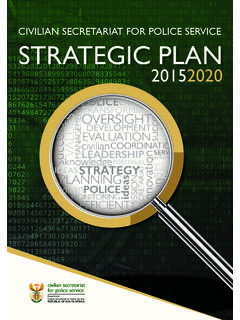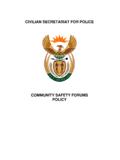Transcription of CIVILIAN SECRETARIAT FOR POLICE
1 1 CIVILIAN SECRETARIAT FOR POLICE GREEN PAPER ON POLICING 2 Table of Contents SECTION 1: BACKGROUND .. 4 Impact of crime on a developmental state .. 7 Changes in policing since 1994 .. 8 SECTION 2: INTRODUCTION ..13 SECTION 3: CONFRONTING CRIME IN DEMOCRATIC SOUTH AFRICA ..14 Approaches to addressing crime ..16 SECTION 4: POLICING IN SOUTH AFRICA ..17 Role of the POLICE ..17 Ensuring effective policing ..17 A single POLICE service ..18 Transformation ..20 The POLICE as a Service ..21 Community-oriented policing ..23 Crime prevention ..24 Crime information Visible policing ..25 Crowd management ..27 Rural safety ..29 Crime Intelligence ..29 Intelligence-led policing ..30 Crime investigations ..31 Forensics ..34 Basic service delivery.
2 35 Effective local policing ..36 Community Policing Forums (CPFs) ..37 Targeted priority crime approach ..38 SECTION 5: MAINSTREAMING POLICE PROFESSIONALISM ..42 Structuring of the POLICE ..42 Recruitment ..43 Training ..43 3 Promotion ..45 POLICE performance measures ..46 Internal and external corruption ..47 New technology ..51 Command, control and Assurance and compliance ..54 Inspectorate ..54 SECTION 6: INSTITUTIONAL ARRANGEMENTS AT NATIONAL LEVEL ..55 Minister of POLICE ..55 South African POLICE Service ..56 CIVILIAN SECRETARIAT for POLICE ..58 Independent POLICE Investigative Directorate ..59 Private Security Industry Regulating Authority ..60 SECTION 7: INSTITUTIONAL ARRANGEMENTS AT PROVINCIAL LEVEL ..62 Role of provincial government.
3 62 Implementation forum: MINMEC ..62 Provincial safety and security ..64 Role of local government ..65 Delivering crime prevention at local level ..65 SECTION 8: LEGISLATIVE REVIEW ..69 SECTION 9: WAY FORWARD ..70 SECTION 1: BACKGROUND Since achieving democracy in 1994, South Africa has scored many successes in consolidating its approach towards the creation of a safe and secure environment for all its inhabitants. The immediate challenge post 1994 was to reform the policing apparatus into an institution of governance while also dealing with the pressing need to address spiralling crime rates. Ensuring the well-being of all citizens thus became the primary focus of the democratically elected government. This would be partly achieved through the establishment of a transformed, accountable, and accessible Criminal Justice System (CJS).
4 The amalgamation of the eleven policing agencies constituted under apartheid was the starting point for building legitimacy and trust in the newly established South African POLICE Service (SAPS). The need to inculcate a culture of POLICE accountability and an ethos of democratic policing was particularly important considering the historical practices of POLICE brutality and unaccountability. Ensuring transparency and building trust meant that the SAPS would have to be subject to the rule of law and embody the values enshrined in the Bill of Rights. The new philosophy of community-oriented policing also formed a cornerstone of policing post 1994. This approach is predicated on building sustained working relationships with communities built on collaboration and trust.
5 Early strategies regarding the provision of safety and security in the country centred on instilling collaborative working relationships amongst key government departments and stakeholders. This holistic approach was first articulated in the 1996 National Crime Prevention Strategy (NCPS). This strategy was geared towards the development of integrated cross-cutting programmes. Government s policy approach to policing and community safety was cemented in the 1998 White Paper on Safety and Security. The object of the paper was to provide a comprehensive policy framework that would direct the implementation of a more holistic approach towards safety and security in South Africa until 2004.
6 The key focus areas of the White Paper aimed at enhancing service delivery were law enforcement, crime prevention and institutional reform. 5 The notion of social crime prevention as an approach to curbing and reducing high levels of crime was embedded in this policy. Provision was also made for the development of community-based crime prevention plans signalling an increased responsibility of local government to combat and prevent crime. While the broad policy thrust was largely understood, effective implementation was limited by conceptual differences between crime prevention and crime combating. The roles and responsibilities assigned by these concepts were at times not properly understood by key role players.
7 This created expectations that the POLICE would fulfil functions that fell outside their core mandate rather than positioning itself as a specialised agency. During the late 1990s growing concern about high crime, particularly violent crime, meant that short-term law enforcement solutions were favoured over more long-term developmental ones. These short term approaches to dealing with crime however created tensions between the need for short-term results in reducing crime vis- -vis a long-term developmental approach to addressing the roots causes of crime that was central to the NCPS. While the SAPS continued to fulfil social crime prevention responsibilities, it became increasingly evident that the POLICE had limited scope in influencing the complex interplay of social, economic and environmental factors that impact on crime.
8 Assigning the SAPS with the primary responsibility for reducing crime, particularly those beyond its control like social contact crimes hampered the effective implementation of the NCPS. Proper implementation was further hamstrung by the inability of key stake-holders and role-players to coordinate effectively on cross-sectoral programmes. A constantly evolving crime and policing landscape also meant new demands were being placed on the South African POLICE Service which required a re-think in terms of policy and strategy. Nearly two decades into democracy the POLICE and policing has undergone many changes in an attempt to provide adequate responses to crime. Crime prevention approaches and strategies have been closely tied to the broader constitutional vision of ensuring that all citizens are safe and secure.
9 The development of targeted responses to crime and safety over the long-term must therefore be guided by a 6 sober analysis of the successes and challenges regarding policy implementation. Assessing government s progress on the provision of safety and security broadly requires analysing the impact of the objectives along with the outcomes outlined in the 1998 White Paper on Safety and Security.. Against the backdrop of some of the challenges identified above it has become necessary to conduct a thorough review of the 1998 White Paper on Safety and Security. The review process is informed by the need to reexamine important safety, security and policing policy issues, highlight gaps in the implementation of multi-agency approaches, and identifying additional measures for building a professional and responsive POLICE service.
10 Government-wide consultations on the draft White Paper on Safety and Security identified the need for a more coherent policy framework that will inform the development of policing strategies and operations over the medium- to long-term. Linked to this is the recognition that strengthening professionalism, and enhancing accountability and transparency are central to achieving the organisation s broader transformation objectives. This Green Paper on Policing sets out the broad policy thrust for the South African POLICE Service over the medium- to long-term. This policy must position the POLICE service to adapt and respond to a constantly evolving crime landscape while remaining steadfast in its commitment to democratic policing.


















